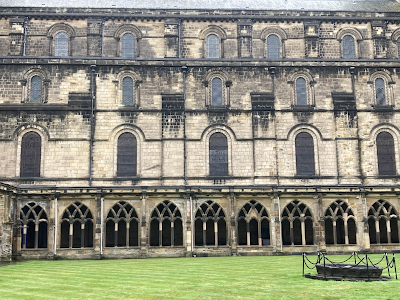To go on pilgrimage is to engage a vision of God. It is a mystical striving to see ourselves traveling from/to/for/with/about the transcendent.
But what do we make of such experiences once we return to our everyday lives?
As a journey takes time, pilgrimage invites us to consider various modes for processing time. Pilgrimage is a sustained engagement with sacred time, but it is not the only way of functioning in that mode. Regular participation in corporate worship is the most familiar way, and in our sabbaths, we pause something of our mundane concerns and return to the metanarrative of our tradition. Retreat is another way of infusing our perception of time with a sense of sacredness and is often defined by an intentional quieting to listen for "the heartbeat of God." Pilgrimage is distinct from worship and retreat as it typically incorporates physical travel to move us spiritually.
As we do that traveling with others, we become mindful of the uniqueness of each pilgrim receiving the divine through their own spirituality and history. We understand our shared journey in ways distinct to our own conditioning while our understandings of ourselves are challenged by traveling together.
As we return from pilgrimage, we have many stories to tell, and we go through a process with those stories that is as old as inspiration itself. We are fortunate to have lived the very context of the stories. We were present for all the details, and pilgrimage provides the added benefit of being able to compare our memories with those of fellow pilgrims. Beyond those rich resources of first-hand knowledge, we provide interpretation as we tell our stories. We know what was most meaningful to us and we continue to track that meaning as it develops in our spirits. Finally, we have opportunities to apply that meaningfulness. As we pursue those opportunities, we find ourselves following the dictum of Father Gildas of Caldey Abbey: "What matters most is what we individually make" of the ways God has come to us.
What forms might that making take in the weeks and months following a pilgrimage?
Sensitive consideration is needed to answer this question. This is due in no small part to the reality that the thin places visited on such a journey are famously "homes for pilgrims" meaning people of a pilgrim orientation find a welcoming freshness in them. Not everyone resonates with this phenomenon, and its great purity can seem impossibly far from our everyday lives. So it is that our usual settings are the places most in need of the perspectives of pilgrims.
Perhaps our best hope going forward is to patiently seek a gentle integration of the gifts of those wonderful times wherever we find ourselves. To do so, we might need to navigate undercurrents of disappointment or even despair. Maybe we have failed to follow through on possibilities of a new way of life we glimpsed on pilgrimage, but the effects of our journey are still within us. Such holy stirrings survive whether we nourish or neglect them, and often, it simply takes more time than we imagine to discover all that these urgings might become.











